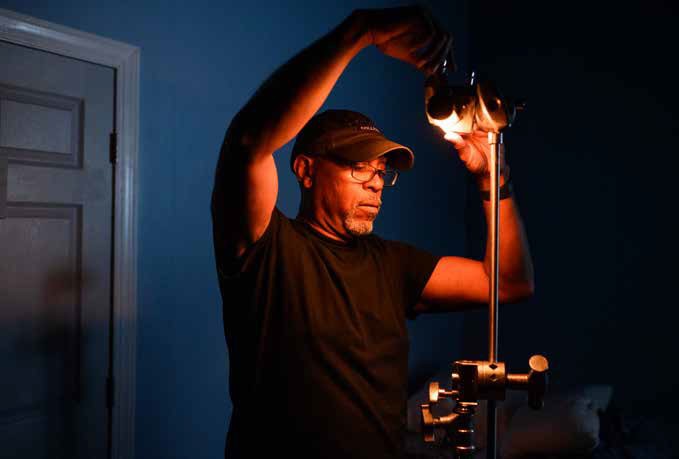The Long (Book) Goodbye
The art (and math) of building a bookshelf bucket list.
Read The StoryStudents learn the secrets of visual storytelling in “Basic Cinematography,” taught by Jonathan Tazewell ‘84.

WHEN & WHERE: Wednesday, 1:10 – 4 p.m., Wright Center 203
Think, for a moment, about your favorite movie. Did it have a compelling storyline that stuck with you over the years? Did you love it because of the lead actor’s stellar performance? Or maybe you just couldn’t stop humming the tune that won an Oscar for best original song. What you might not have considered is the talent and skill it takes to make every single shot look just right. That’s because when it comes to movies, the role of the cinematographer usually goes unnoticed — unless something goes wrong.
This less glamorous work, the hidden essence of movie magic, is what Jonathan Tazewell '84 (pictured above) teaches in FILM 243 (Basic Cinematography.) Through a series of group projects that require coordination with writing and directing classes, students learn to work closely with peers rather than focusing on themselves as dictatorial auteurs. “A big part is really teaching students how to create collaboratively,” Tazewell said. “It’s about listening. It’s about giving up some of your own ego in order to allow for that listening, and then it’s about engaging and being responsible for providing your part of whatever the job is to make the vision.”
Just as a solid grasp of grammar is a prerequisite to tell a good story in words, a focus on the mechanics of lighting and lenses is critical to making a successful film. “The course is trying to get students to understand the process of telling visual stories from the viewpoint of the camera, rather than the viewpoint of the writer or director,” Tazewell said. Using the online database ShotDeck, students can access still images from thousands of films to analyze how innumerable decisions about lighting, color, angles, depth of field and more influence the final product.
One of Tazewell’s first assignments requires students to use their own cameras, smartphone or otherwise, to re-create an image of their choosing from a gallery Tazewell provides — which includes not just photographs, but paintings by artists including Edward Hopper. By figuring out how to use real-world locations and lighting to approximate the moodiness of Hopper’s imagined worlds, students have to think more deeply. “So many wonderful cinematic things actually come out of painting,” Tazewell said. We use chiaroscuro all the time in film noir and other gloomy, dark stories. But Caravaggio is painting this kind of stuff. You have artists who are able to see and recognize this style of lighting and then create it on the canvas, and now we’re asking the students to recreate that again.”
Later in the course, students borrow the state-of-the-art equipment housed at Kenyon’s Wright Center in Mount Vernon, but Tazewell emphasizes that filmmaking is not ultimately about having the biggest budget or most advanced gadgets. “We have very fancy cameras and lights and things, and we have to teach students how to operate those things, but they’re just really fancy pencils,” Tazewell said. “It’s not any more important than a pencil. It’s really just the tool that you need to use.”
“Cinematography: Theory and Practice: Image Making for Cinematographers and Directors,” by Blain Brown
“On Film-making” by Alexander Mackendrick, edited by Paul Cronin
The art (and math) of building a bookshelf bucket list.
Read The StoryWhy Paul Newman is having a moment. Again.
Read The StoryA conversation with outgoing president Sean Decatur about science, higher education and his groundbreaking new…
Read The Story